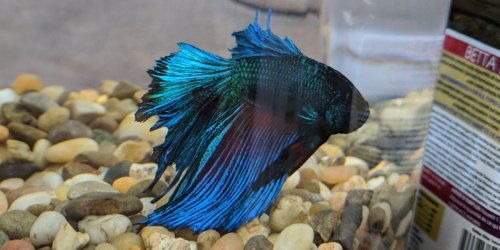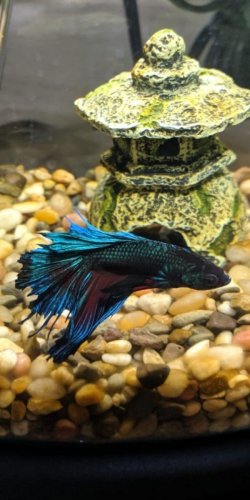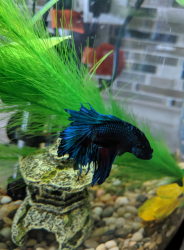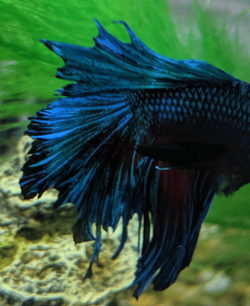My apologies, I was posting the long information above at the time of your last post. Yes, I would do another 75% water change and keep an eye on everything. Looking good!
You are using an out of date browser. It may not display this or other websites correctly.
You should upgrade or use an alternative browser.
You should upgrade or use an alternative browser.
Tough fin rot case
- Thread starter Susan Perpich
- Start date
April FOTM Photo Contest Starts Now!

🏆 Click to enter! 🏆
Susan Perpich
New Member
- Joined
- Apr 2, 2019
- Messages
- 17
- Reaction score
- 0
Hi,
Have an update and question. I did get his tank cycled and he is doing better. His tail isn't getting worse but it doesn't seem to be getting any better. Just wondering how long it takes to see improvement? His tank has been cycled about two months now. All the water tests come out good. I attached two pictures. First picture is from April 1st and the second is from June 23rd.
Have an update and question. I did get his tank cycled and he is doing better. His tail isn't getting worse but it doesn't seem to be getting any better. Just wondering how long it takes to see improvement? His tank has been cycled about two months now. All the water tests come out good. I attached two pictures. First picture is from April 1st and the second is from June 23rd.
Attachments
Susan Perpich
New Member
- Joined
- Apr 2, 2019
- Messages
- 17
- Reaction score
- 0
Is there anything I can do for him to get that to grow again?
The best things to do to help fish heal and regrow fins is:
1) Feed them 3-5 times a day, and feed them a varied diet to maximise the nutrients they get.
2) Do big (75%) water changes and gravel clean the substrate every day or two, to help reduce the nutrients and number of disease organisms in the water.
Make sure new water is free of chlorine/ chloramine before it's added to the tank.
3) Make sure the filter is cleaned regularly. However, don't clean a filter if it is new and less than 6 weeks old.
You do these thing for 2-4 weeks while the fish is healing and repairing the damage. After it is healed, you reduce feeding to once or twice a day, and reduce the water changes to once a week.
1) Feed them 3-5 times a day, and feed them a varied diet to maximise the nutrients they get.
2) Do big (75%) water changes and gravel clean the substrate every day or two, to help reduce the nutrients and number of disease organisms in the water.
Make sure new water is free of chlorine/ chloramine before it's added to the tank.
3) Make sure the filter is cleaned regularly. However, don't clean a filter if it is new and less than 6 weeks old.
You do these thing for 2-4 weeks while the fish is healing and repairing the damage. After it is healed, you reduce feeding to once or twice a day, and reduce the water changes to once a week.
Susan Perpich
New Member
- Joined
- Apr 2, 2019
- Messages
- 17
- Reaction score
- 0
Thanks a ton. I'll give that a try.
Susan Perpich
New Member
- Joined
- Apr 2, 2019
- Messages
- 17
- Reaction score
- 0
Back again. I've been doing big water changes every two-three days and feeding three to four times a day for the last 4 weeks. His filter has been in there for 2 months and I rinsed it once. He isn't showing any signs of improvement. He's not getting worse but not getting better. I'm at a total loss of what I can do. Any suggestions?
Susan Perpich
New Member
- Joined
- Apr 2, 2019
- Messages
- 17
- Reaction score
- 0
Is he swimming around more and eating well?
His fins look better in the latest pictures. They haven't grown back but they don't look infected. It's possible they won't grow back to their original size due to damage that was done to them.
How is the water quality (ammonia, nitrite, nitrate and pH)?
When you cleaned the filter, how did you do that?
I would keep feeding him well and keep doing regular water changes, (once every couple of days should be sufficient) for a couple more weeks and keep an eye on the water quality. If you get any ammonia or nitrite readings, or the nitrates go above 20ppm, then do a 75% water change immediately.
His fins look better in the latest pictures. They haven't grown back but they don't look infected. It's possible they won't grow back to their original size due to damage that was done to them.
How is the water quality (ammonia, nitrite, nitrate and pH)?
When you cleaned the filter, how did you do that?
I would keep feeding him well and keep doing regular water changes, (once every couple of days should be sufficient) for a couple more weeks and keep an eye on the water quality. If you get any ammonia or nitrite readings, or the nitrates go above 20ppm, then do a 75% water change immediately.
Susan Perpich
New Member
- Joined
- Apr 2, 2019
- Messages
- 17
- Reaction score
- 0
He does act normal. He's very interested in what we are doing and he eats well. Swims around and seems happy. I rinse his filter in the sink with tap water but I only rinse it a little. Just to get it a little cleaner. Did his water test today and they are PH-8, Ammonia-.25, Nitrate-5, Nitrite-0. I did a 75% water change on 7/22.
You don't want to wash filter media under tap water because the chlorine/ chloramine can kill the beneficial filter bacteria.
When you clean the filter, get a bucket of water from the tank and squeeze the filter media out in the bucket of tank water. When it's clean, put it in the tank and then wash the filter case under tap water. When the filter case is clean, put everything back together, fill it with tank water and get the filter going.
When you clean the filter, get a bucket of water from the tank and squeeze the filter media out in the bucket of tank water. When it's clean, put it in the tank and then wash the filter case under tap water. When the filter case is clean, put everything back together, fill it with tank water and get the filter going.
Susan Perpich
New Member
- Joined
- Apr 2, 2019
- Messages
- 17
- Reaction score
- 0
I have well water so I don't think there is chlorine/chloramine in it. I use bottled water from the store for his tank water. I have replacement filter cartridges that I just put in the filter. They are all assembled already. There is no ammonia chips in it tho. Do I just rinse that entire cartridge in tank water in a bucket then? Should I add ammonia chips some how? How often should I be rinsing it? Maybe I rinse it too much. Thanks for all the advice!
I would use sponges instead of filter pads/ cartridges. You can buy sponges for different brands of filter and cut them to size with a pair of scissors. I use AquaClear sponges but there are plenty of other brands. Filter pads are a sales ploy by companies to get you to keep buying their products. The filter pads are usually poor quality and don't last long, whereas a sponge will last 10+ years and simply get squeezed out in a bucket of tank water and re-used.
When you replace the filter pads you get rid of the beneficial filter bacteria that keep ammonia and nitrite at 0, and your fish suffer because of that. It then takes another month or so for the bacteria to develop on the new pads and when they get replaced, you start all over again. It means you have constant ammonia and nitrite problems in the water and the fish suffer. This could be why your fish is still having trouble with his fins.
I would look for some sponges and cut them to fit in the filter.
If the current filter pads/ cartridges are new (less than 1 week old), remove them completely and put sponges in their place. If the cartridges have been in the filter for more than 2 weeks, I would add some sponges to the filter and leave the pad in there. Wait a month or so and then remove the cartridge and put more sponge in the filter.
You can get round/ cylindrical sponges for some brands of internal power filter. These sponges have a hole through the centre and can be put over the intake strainer of most external power filters. They trap gunk and also hold beneficial filter bacteria and can be used in conjunction with other sponges and cartridges in the main part of the filter.
Do not add any ammonia adsorbing granules. Just keep doing water changes and let the filter develop the good bacteria. Hopefully in about a month's time, the sponges should be full of good bacteria and the fish will be able to carry on with its life.
-------------------------
Filters should be cleaned at least once a month and every 2 weeks is better. However, do not clean a filter for the first 6 (preferably 8) weeks otherwise you can wash off the beneficial bacteria and start the cycling process over again.
-------------------------
You should check your tap water for ammonia, nitrite and nitrate. Sometimes well water can become contaminated and cause problems to fish and anything that drinks it.
When you replace the filter pads you get rid of the beneficial filter bacteria that keep ammonia and nitrite at 0, and your fish suffer because of that. It then takes another month or so for the bacteria to develop on the new pads and when they get replaced, you start all over again. It means you have constant ammonia and nitrite problems in the water and the fish suffer. This could be why your fish is still having trouble with his fins.
I would look for some sponges and cut them to fit in the filter.
If the current filter pads/ cartridges are new (less than 1 week old), remove them completely and put sponges in their place. If the cartridges have been in the filter for more than 2 weeks, I would add some sponges to the filter and leave the pad in there. Wait a month or so and then remove the cartridge and put more sponge in the filter.
You can get round/ cylindrical sponges for some brands of internal power filter. These sponges have a hole through the centre and can be put over the intake strainer of most external power filters. They trap gunk and also hold beneficial filter bacteria and can be used in conjunction with other sponges and cartridges in the main part of the filter.
Do not add any ammonia adsorbing granules. Just keep doing water changes and let the filter develop the good bacteria. Hopefully in about a month's time, the sponges should be full of good bacteria and the fish will be able to carry on with its life.
-------------------------
Filters should be cleaned at least once a month and every 2 weeks is better. However, do not clean a filter for the first 6 (preferably 8) weeks otherwise you can wash off the beneficial bacteria and start the cycling process over again.
-------------------------
You should check your tap water for ammonia, nitrite and nitrate. Sometimes well water can become contaminated and cause problems to fish and anything that drinks it.
Latest Discussions
- Replies
- 8
- Views
- 146
- Replies
- 12
- Views
- 150
trending
-
-
-
-
-
F-1 Angel... a bit nervous... it'll be my 1st F-1 fish...
- Started by Magnum Man
- Replies: 16
Staff online
-
emeraldkingModerator
Members online
Total: 525 (members: 8, guests: 517)






